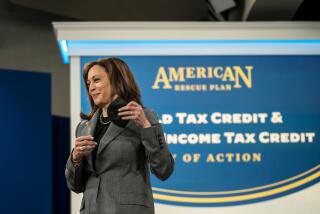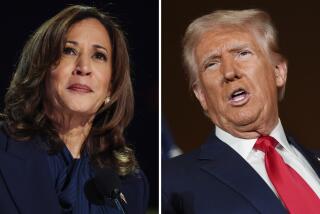Overhaul Is at the Top of Tax Agenda
- Share via
What’s next for taxes?
Despite the lack of agreement on a tax package over the last year, all parties expect a major overhaul in the next two years. Rep. Bill Archer, the Texas Republican who chairs the House Ways and Means Committee, is expected to unveil his 1996 agenda Wednesday. Last weekend, Archer attended a retreat with Republican and Democratic members of the tax-writing panel.
A flat tax was recently viewed as a front-runner in the tax-reform race. The idea got many headlines as Republican presidential candidate Steve Forbes campaigned almost solely on the plan’s purported economic benefits.
Archer said he doesn’t believe that Forbes’ campaign, which appears to be fading, will bode negatively for the tax-reform agenda. However, he said other members of Congress have told him the flat tax that Forbes supports is losing ground with taxpayers. “It is their sense that the flat tax has peaked and is on decline,” he said.
The Texas Republican prefers a proposal that would tax consumption rather than income.
“I still believe we should not tax income as the base for raising our money, but I’ve got an open mind on this,” he said. “Some type of flat tax is certainly an improvement over the current system, but I don’t think it can give us all the advantages that we would like to see.”
The current tax system has five tax brackets--15%, 28%, 31%, 36% and 39.6%--and is based on the theory that those with more of the wealth should shoulder more of the tax burden.
Under a true flat tax, all income would be taxed at a single rate and all tax deductions and preferences would be eliminated. Supporters say it is a fairer code and critics say it would increase the tax burden on middle- and low-income Americans.
A plan put forward by House Majority Leader Dick Armey (R-Texas) would tax all income at a 20% rate, which would fall to 17% if economic growth is stimulated by the new system. Armey’s plan would repeal all tax preferences and deductions, but would install protections for poor Americans, in many cases eliminating their federal tax bill altogether.
A key point of contention in this plan is the proposed elimination of all tax preferences and deductions--including those that many middle-income Americans count on, such as those for home mortgage interest and charitable contributions.
Without eliminating the deductions, the Treasury would get far less revenue than it does now, making the plan unworkable unless there were vast changes in government spending.
Earlier this year, a commission headed by Jack Kemp, a former congressman and Cabinet secretary, recommended that the U.S. move to a single-rate system. The panel acknowledged, though, that there would be political problems associated with killing the popular deductions.
One area on which almost all tax-overhaul proponents agree is that the new code should encourage savings and investment.
The personal savings rate in the U.S. bounced up to 4.3% of after-tax income during the first three quarters of last year, reversing a long decline from a high of 9.3% in the 1970s to a low of 3.8% in 1994. Historically, Americans save less than do citizens of other industrialized countries. The rates for Japan and Germany exceed 10%.
More to Read
Get the L.A. Times Politics newsletter
Deeply reported insights into legislation, politics and policy from Sacramento, Washington and beyond. In your inbox twice per week.
You may occasionally receive promotional content from the Los Angeles Times.










